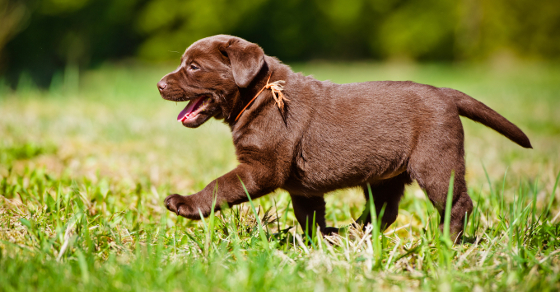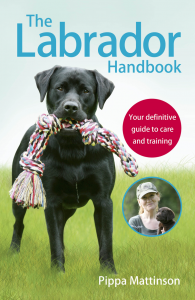Training a Labrador puppy is a lot of fun, provided you have some sensible, practical information and advice at hand.
And that is what this website is all about.
You’ll want to know
- How to train your puppy
- What to train your puppy
- When and where to start training
Let’s not waste any time!
How to train your Labrador puppy
Its a good idea to look into the different methods and techniques that can be used for training a dog before you get started with training your puppy
Modern puppy training methods are gentle, positive, and very effective, and that’s what your will find on this website. Smacking and rolled up newspapers are thankfully a thing of the past!
All our training exercises and instructions come with full explanations of how to achieve the right results.
Five stages
We train each skill in five stages
- Get it!
- Pair it!
- Teach it!
- Proof it!
- Maintain it!
#1Get the behaviour
This is the part where you get the puppy to do the thing you want over and over again, so that you can reward him. The thing you want might be a sit, or a down, or a paw shake. It might be that you want your puppy to run towards you
Whatever it is you want, the first stage is to encourage the puppy to do that. Sometimes we use food lures to get the behaviour, for example, we can lure a puppy into a sit by moving a food lure backwards over his head.
Sometime we can use the puppy’s natural instincts. For example when you run away from a puppy to get him to chase after you.
Rewards are the key
Each time the puppy does what we want him to do we give him a nice tasty treat. This makes him want to do it again and again.
When a puppy starts doing the thing we want him to do repeatedly, of his own free will, then we have ‘got’ that behaviour. When we have ‘got the behaviour’ then we can start to give it a name – we call this name a ‘cue’
#2 Pair it with a name!
Here’s the bit where your puppy goes to language classes!
Naming your puppy’s behaviour is important. A lot of people think their puppy will automatically know that sit means sit. But he won’t
Now you have got him offering you a behaviour you like, you can teach him the human name for that behaviour.
You need to teach him by association. It’s kind of a game of pairs.
Playing pairs
So you need to pair the action of sitting, with the word sit. And to pair the action of running towards you with the word come.
You don’t need to use these exact words by the way – you can make your own up if you want to!
Playing the pairing game is easy. Each time your puppy sits, you’ll simply say ‘sit’. No fuss, no bother, just say the word as his bottom hits the floor.
And next time he runs towards you, you’ll say ‘come’ as he flies into your arms. Don’t forget those tasty treats though.
For a more detailed explanation of each of these processes check out the individual training instructions for
Once you’ve played the naming game, you can get to the really fun part. You can teach your puppy to respond to your cue word.
#3 Teach the response to the cue
This is the part where people used to begin with dog training using traditional methods. But of course, because they hadn’t completed the first two stages, their puppies didn’t have a clue what their cue meant.
This meant traditional trainers often had to push and pull their puppies into position. Usually while saying the cue word over and over again.
This was quite tough on the puppies as you can imagine.
Sadly, because dog training is not regulated, you can still find trainers like this, teaching puppies by dragging them about and barking instructions at them. I don’t need to tell you that these trainers are best avoided.
No pushing and pulling
Nowadays, we get the puppy paying attention to us, which is easy because he associates us with games and rewards, and we say our cue word and wait for him to respond.
If he doesn’t do it the first time, we give him some encouragement – lure him into a sit for example, or run away from him to get him coming towards us, and then reward him as usual.
It doesn’t take long for the puppy to respond to our cues, because he already knows what they mean. You won’t need to push him into a sit, or drag him towards you.
Of course, we don’t give him the cues when he is distracted, that is what stage 4 is all about.
# 4 Proof the response we just taught the puppy
Proofing is just a fancy word to getting it right no matter what. A proofed sit is one that your dog will do anywhere, at the school gates, when visitors arrive, on a bus, in front of other dogs, and so on.
There is a lot of information about proofing on this website, simply because proofing is both the longest and the most important part of the dog training process
#5 Maintain your training for the long term
Most people cope well with stage five. The fact is, once you’ve completed stage four, it’s pretty much downhill all the way.
Maintaining your training means observing your dog and rehearsing good behaviours that have got a bit sloppy.
It means taking the time to have a few refresher sessions occasionally for those skills that need brushing up. And remembering to keep rewarding your dog from time to time.
You can do that standing on your head.
Training your puppy can be challenging at times, but it is an important part of puppy care and management. Good behaviour is also a key ‘safety feature’ where a large and relatively powerful dog is concerned.
Big dogs and safety
When you look at your adorable eight week old puppy, it may seem hard to believe he could ever harm anyone, but he won’t be small for long.
A full grown Labrador can easily knock a person over or drag them along on the end of a lead. Or cause a serious accident if he were to stray onto a road.
So it’s worth spending some time finding out how to go about the important task of educating your pup, and bringing him up to be a gentle and obedient adult.
What to teach
For safety’s sake, the minimum any Labrador puppy should learn is how to sit and to wait calmly to be stroked or fed, and how to walk nicely next to his owner on a lead.

Tricks versus serious training
Many people separate dog training, in their mind, into tricks versus ‘real’ training. In fact, everything you teach your dog is in a sense a ‘trick’. And all tricks are a valuable form of training.
You may well benefit by teaching some tricks to your puppy before getting on to the serious stuff.
This is because you are less likely to feel pressured to succeed with trick training, and therefore more likely to keep training fun and to speed up the learning process for your dog.
Trick training also teaches you to be a better trainer, by improving your skill and timing with practice.
When to teach
With modern training methods, which are largely force-free, training can begin at a very early age.
The secret to successful early training lies in keeping the whole process stress free and cheerful.
Your puppy should have no idea he is being trained, and he will enjoy his training sessions as if they were games. So, provided you teach your puppy using modern, positive reinforcement training techniques, you can start from day one.
If you are not sure what constitutes modern training, or positive reinforcement training, visit our sister site Totally Dog Training for more information and advice.
More information
You will find lots of information on puppy training right here in our training and puppy sections.
Check out our popular Recall Training Centre to help you get this important skill underway, and find out how to get your puppy walking nicely next to you with our Clicker Heel article
You will also find information lots more information on other aspects of puppy care in our labrador puppies section.
One article you may find particularly helpful is : ‘How to train a puppy to sit’ To make sure you don’t miss any of our other articles, you can request free email updates.
More information

Check out our Labrador Puppies and Training sections for more help and advice on life with your new puppy.
If you’d like loads more training assistance, don’t miss my new book, due to be released in September 2015
The Labrador Handbook looks at all aspects of your Labradors life, through daily care and training at each stage of their life.
Click here(paid link)to pre-order now from Amazon UK, with Amazon’s pre-order price guarantee
(Training a Labrador puppy was originally published in 2011 and has been revised and updated for 2015)
The Labrador Site Founder
Pippa Mattinson is the best selling author of The Happy Puppy Handbook, the Labrador Handbook, Choosing The Perfect Puppy, and Total Recall.
She is also the founder of the Gundog Trust and the Dogsnet Online Training Program
Pippa's online training courses were launched in 2019 and you can find the latest course dates on the Dogsnet website



















I know Labs in general are very easy to train dogs, but I have a 3 month old chocolate lab and she just amazes me!!! She basically let me know she was ready for training because she essentially learned “sit” on her own! Whenever I had something for her in my hand (food bowl, treat, toy) I waited til she sat down to give it to her. Eventually I noticed my hand in a closed fist even with nothing in it meant sit for her, after a mini session I tested it out and was right! I realized I was the one who was actually falling behind from her so I stepped up the game and now Scooby knows sit, lie down, and roll over all in just a week and a half!!! She catches onto things INCREDIBLY fast she is sooo smart. Training Scooby is so much fun, all it takes is a short 15 minute practice session each day to keep her mind fresh! Just wanted to share this story about how great Labs are 🙂
That’s lovely Alyssa, so pleased you are having such fun training your dog. 🙂
Hi Pippa,
Could you please point me in the right direction in regards to teaching my lab puppy not to bite us? Thank you.
Hamnah.
Hi Hannah, this is the article you need https://www.thelabradorsite.com/labrador-puppies-biting/
How should I teach my 6 month old lab to bark at strangers?
Hi . Bit of advice please on how to stop our 18 month old from running up to other dogs not in an aggressive way just an over friendly way. He hasn’t been neutered.
Hi! I have a 15 week old male black lab puppy who has stolen our hearts! I found him off of a posting online. When we went to go pick him up, we found him in a run down, disgusting place. He was malnourished, and the mother was no where in sight. Normally I know this is a danger zone for picking a puppy, but I couldn’t leave him behind. I knew if I did he would be dead.
We have had him 3 weeks now, and he is healthy, hearty puppy. (his vet gave him the all clear). However my fiance and I noticed that he went from licking us to biting us, and he tends to growl. When we scold him he only barks back. I’m worried we might not break this behavior, and I don’t want him like this as an adult. How do we stop him from biting us and growling and just be a loving puppy?
-K
Hi Kaitlyn, all puppies bite and growl, check out this article on coping with biting. Your puppy may also be short on socialisation. You’ll need to spend some time on this https://www.thelabradorsite.com/the-importance-of-socialising-your-labrador-puppy/
Hi,
I have two months old labrador puppy, i wanna potty train for her, how to do that pls help me
Nayanathara
This is the article you need
Hello,
I have a beautiful 6.5 lb. baby girl named Rarri who is 9 weeks. She is actually half lab half German Shepard and quite beautiful. Already she is showing how playful she can be, and bites many things, she loves to wake us up at 6 am (no joke) We are kennel training her and I do not know much about training a puppy although I am aware both breeds are very smart, playful and large in size. I cannot express how excited I am to see her grow I actually hope she is larger than average since she is a mix! That would be great. Although since she is a mix I am worried this can become a problem when training her?
Hi Alyssa, the fact that she is mixed breed will make no difference to her training. Enjoy your puppy 🙂
Hello
I have two labras one is female and the other is male female is stella and male is shadow this is my very first experiens with dogs and theyy are out of control they dont know anything like when i say sit they dont i say stand they dont when they are playing the dont even stop and listen to what i am saying now plz tell me what should i do to make them good plz help me
My mother bought a beautiful 6 week old golden lab girly for my little sister (4 years old) and myself to own a few days ago, and she is struggling to be potty trained. I have tried lots of different ways, such as closing her off in just the garden or holding her until she whines and needs to wee. After all of it, she just won’t wee. Only once I take her from there and put her down does she wee. She has begun to favour our carpet, despite spraying and cleaning her wee every time. Are there any good secrets to training her to wee in the garden? (She will be an outside dog, but we don’t want her to wee on the patio.) Please give me some advise.
Hi Isabella, here is the article you need. You might also find it helpful to join the forum for support from other puppy owners. Pippa
hi, i have a 5 week old cute little lab .. i got it 2 days back.. on the first night he didnt sleep at all.. and didnt leave us to sleep,but i think its normal for it in a new place right?.. in the past two days all he did was eat n sleep… is it okay?.. wl it take more time to adopt??
I have approx 2 mnths old female lab… Her name is Kyra… And I love her…She is so playful but mouths so hard when excited… Everytime it leaves a big scratch of her sharp tooth… I have tried all time out sessions etc… But still when she become excited she bites badly… Please help…
I normally have a toy handy and replace my appendage with said toy. Another thing my mom does that seems to work is Mom actually yelps, like another puppy would if she was playing too rough with it. Idk how Mom figured it out, but I’ve had success with that.
We have a 4 month old yellow lab puppy ” Major” he’s the greatest puppy we’ve ever had, we had Siberian husksys before & just had no luck, Major is already SO much more loving, loyal & caring..and he’s a perfect family dog however…we can’t get him to get potty trained all the way yet. We have gated him off into the kitchen until we get him house broken. (Is that bad?) He usually barks if he has to go out so, we’ll leash him & take him. We have him on a eating schedule& every time after he eats we always take him out. He’ll go pee outside & does great but, never fails…He’ll come right back in & pee on the kitchen floor….ugh! Please help!!!!!!!!
Hi there, check out all the house training articles in the Puppy Care section. You might also find it helpful to join the forum. Lots of other puppy owners there 🙂
I have a 9 month old lab who bites (well, more like mouths but it can turn into biting when he really gets going) When will this stage stop? I correct him by saying no, and walking away from him but sometimes I think he thinks its a game. Any advice?
I’ve had a few dogs (2 Jack russles and 2 labs) how I stopped my dogs from thinking I was a toy was to substitute my hand/leg/foot/FACE/hair with a toy. what my dogs have gone for in the past is rawhides particularly the ones with the red stuff wrapped in them.
When you have your dog near you have a toy/rawhide handy, then when he starts to mouth you:
Put the toy in his mouth and play with him. You are not a chew toy lol.
I just bought a 4 month old black lab last Saturday I bought a large pen in the basement for him. He won’t stop barking I am home for 2 weeks to train him I put him in the pen 3 times a day for half hour he will not stop barking I am concerned when I have to go to work I work from home 3 days a week.
Hi John,
Have a look at this article: Click for Quiet
Pippa
I have a 14 week old lab and may need some info about making this a fun time .Bud
Hi Bud, hope you find the articles in this section helpful. Pippa
Hi
How to know the age of my yellow labrador and how to know if my puppy is pure labrador breed
garry
Hi Garry, no one can tell you these things without any information I’m afraid. If you post a picture up of your puppy in the forum we might be able to give you a very rough idea of age, but unless he is clearly not a pure bred Labrador, we probably can’t help you with the other question.
Pippa
update on how to train my 2 months Labrador puppy
Do you have a question Desmond? Or do you want to post a story about your puppy?
Hi
My Labraodor puppy is 9 weeks old and has been with me for 1 week. He is wearing a collar fairly happily but rolls over and chews the lead every time I put it on. He does not seem to be afraid of it but wants to chew anything he comes into contact with.
How can I get around this?
Liz
Hi Liz,
Your puppy’s reaction is pretty normal. The lead is a bit of a novelty for now. Just pop it on for a few moments and keep the lead held so it goes straight up from the back of his collar to your hand. Then distract him with plenty of walking up and down, changing direction every few steps and lots of encouragement. Dropping the odd treat behind you as you go will also keep his mind off the lead.
Fortunately your puppy doesn’t need to walk on the lead just yet so you can keep ‘lead times’ very short, just a few seconds, several times a day and he will soon get used to it.
Pippa
Hi, my friend has a beautiful black female lab just under a year old. She was a rescue dog and totally loves her. However, she has consistently eaten her leather chair, her shoes, clothes, jewelry, any food on the counter to name a few. She jumps on her owner and I only, and recently started sniping at my hands and clothes, as well as her owners. My friend works full time and has asked me to help train the dog or look for a dog trainer since I introduced them 🙂 Help! What should I do?
Hi Diane,
Not sure if you are asking whether you should go ahead with taking on the dog, or how to go about it?
Are you considering having the dog in your home all day, full time? Young Labradors are often very destructive if left unsupervised. This can go on up to around two years of age. Do you have a crate? Do you have room for a crate? Are you willing to devote some time to reading and learning about canine behavioural modification and training techniques?
You might find it helpful to chat to other Labrador owners on the forum and to read through the articles in our Training and Behaviour sections
Pippa
I just got a 4 1/2 week lab mix. She’s very active and likes to bite and chew on things. How do I break her from chewing on everything and get her to stop using the bathroom inside?